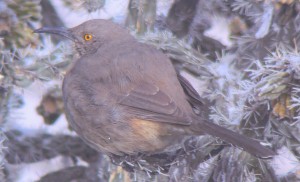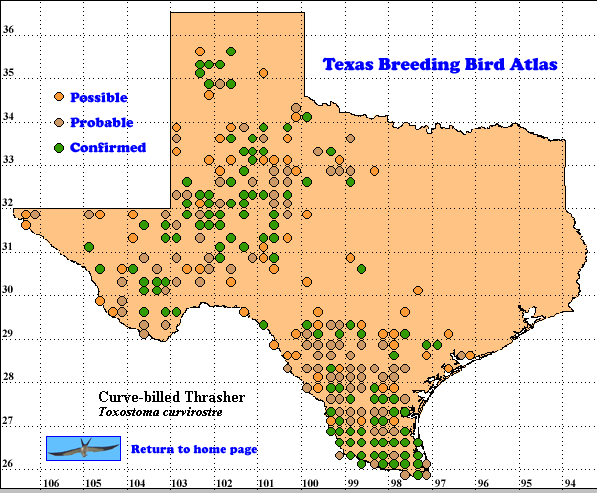The Curve-billed Thrasher is a common resident of semi-open areas dominated by thorny shrubs, mesquite, cactus and yucca. Densities of 90 birds per 100 ha (247 acres) and 76 nests in 99 ha have been recorded in southern Texas (Fischer 1980, 1981). Curve-bills adapt well to humans and often forage in gardens, visit feeders, and nest near rural dwellings. Although described as “shy and rather wild” (Oberholser 1974), they often allow humans to approach closely while they intently watch with an air of inquisitiveness.
Curve-billed Thrashers occur singly or in pairs and are often seen foraging on the ground or flying near the ground from bush to bush. Their characteristic double whistle, whit-wheet, and other calls are usually given from a high perch (Tweit 1996). Several species, particularly the Scissor-tailed Flycatcher (Tyrannus forficatus); , Northern Cardinal (Cardinalis cardinalis) and Pyrrhuloxia (C. sinuatus), are occasionally mimicked (Rylander 1981).
Curve-billed Thrashers forage on the ground using their bills to pick up and toss aside larger items or to remove litter with a side-to-side sweeping motion. Holes of up to 5 cm (2 in) deep and 5 cm in diameter are also dug as the soil is explored for seeds and subterranean insects (Tweit 1996). In southern Texas the food of thrashers includes orthoptera, lepidoptera, coleoptera, arachnida, gastropoda, isopoda and the fruits of granjeno, brasil, anacua, and hackberry (Fischer 1980, 1981, 1983). Thrashers also eat dog food and have been seen to carry the pellets to their chicks (Casto 1996).
DISTRIBUTION: The Curve-billed Thrasher is a permanent resident in the Panhandle and western and southern Texas but is notably absent from the eastern Pineywoods, upper Texas coast and the eastern portions of the central and north-central prairies. Curve-bills occur from near sea level to altitudes of 1890 m (6,200 ft; Oberholser 1974).
SEASONAL OCCURRENCE: Although it has been suggested that curve-bills are partially migratory, they appear to be year-around residents throughout their range in Texas (Tweit 1996). Courtship and nest building begin in early February. Three to 5 eggs are laid with 3 or 4 being the usual number (Oberholser 1974). A nest found in Latilong 29097, Quad A6 contained 6 eggs.
The TBBA data document nests with young as early as February 28 in Latilong 2698, Quad B2 and as late as July 13 in Latilong 31103, Quad D2. Late records for fledging include August 20 (Oberholser 1974) and August 22 in La Salle County (SDC). Nesting appears to peak in southern Texas during May (Fischer 1980) but may vary throughout the range of the species based on temperature and rainfall (Tweit 1996). A replacement brood or a second brood is commonly produced.
BREEDING HABITAT: Curve-billed Thrashers often place their nests in conspicuous locations (Fischer 1980). Both sexes build the nest over a period of as few as 3 days to as long as 4 weeks (Tweit 1996). The nest is generally a deep cup but may be flat with only a slight depression for the eggs. The outer layer often consists of thorny twigs whereas the inner layers are of smooth sticks, roots, and coarse grasses. Fine grasses, rootlets, or hair may be used to line the cup (Bent 1948, Oberholser 1974, Fischer 1980). Average nest dimensions (n=l3) are total width 22.7 cm (8.9 in), cup width 10.7 cm (4.2 in), total depth 17.4 cm (6.8 in) and cup depth 9.8 cm (0.9 in; Fischer 1980).
Nests may be placed from 0.61 to 6.1 m (2-20 ft) above the ground (Fischer 1980). Plants used for nest support include mesquite, cholla, prickly pear, yucca, colima, ebony, live oak, granjeno, blackbrush, huisache and coma (Sennett 1878, Fischer 1980). An Arizona ash and a pine tree at a ranch dwelling in La Salle County were used for nesting (SDC). Sheds and other structures may be occasionally used, e.g. a nest was found by Sennett (1878) in an outhouse in the village of Hidalgo. Although cavities are rarely used, Benners (1887) found a nest in an abandoned woodpecker’s hole in a live oak tree. Nests are often reused in the same year or the following year (Tweit 1996).
The eggs are incubated mainly by the female and she is solely responsible for the brooding of the nestlings (Fischer 1980). During times of food scarcity the parents may feed only the older nestlings allowing the younger ones to
starve (Ricklefs 1965). Curve-bills vigorously defend the nest and will chase all birds, including cowbirds, from the vicinity. The young thrashers fledge when about 14 days (range 11-16) of age. Snakes are believed to be the primary predators of eggs and nestlings (Fischer 1980).
STATUS: Changes in the breeding distribution of the Curve-billed Thrasher since the publication of Oberholser’s account in 1974 include confirmation of its breeding status in the Texas Panhandle and an eastern extension of breeding into the north-central region of the state. The loss of brushland in southern Texas may perhaps be a factor in the relatively small numbers of thrashers seen on breeding bird surveys in Texas as compared with Arizona (Tweit 1996).
In the early 21st century the species is considered common to uncommon in the western half of Texas (Lockwood and Freeman 2004). North American Breeding Bird Survey data from 83 routes in Texas produced statistically significant declines of 3.4 and 2.0% for the periods 1966-2005 and 1980-2005, respectively. (Sauer et al. 2005).
Text by Stan D. Casto (Posted with updates 2006)
Literature cited.
Benners, G. B. 1887. A collecting trip in Texas. Ornithologist and Oologist 12 :48-52, 65-69, 81-84.
Bent, A. C. 1948. Life histories of North American nuthatches, wrens, thrashers, and their allies. Bull. U. S. Natl. Mus., No. 195 .
Casto, S. D. 1996. Use of dog food by birds in southern Texas. Bull. Tex. Ornjthol. Soc. 29.
Fischer, D. H. 1980. Breeding biology of Curve-billed Thrashers and Long-billed Thrashers in southern Texas. Condor 82: 392-397.
Fischer, D. H. 1981. Wintering ecology of thrashers in southern Texas. Condor 83: 340-346.
Fischer, D. H. 1983. Growth, development, and food habits of nestling mimids in south Texas. Wilson Bull. 95: 97-105.
Lockwood, M. W. and B. Freeman. 2004. The TOS handbook of Texas birds. Texas A&M University Press, College Station.
Oberholser, H. C. 1974. The bird life of Texas. University of Texas Press, Austin.
Ricklefs, R. E. 1965. Brood reduction in the Curve-billed Thrasher. Condor 67: 505-510.
Rylander, M. K. 1981. Vocal mimicry in the Curve-billed Thrasher. Bull. Tex. Ornith. Soc. 14: 29-30.
Sauer, J. R., J. E. Hines, and J. Fallon. 2005. The North American Breeding Bird Survey, results and analysis 1966-2005. Version 6.2 2006. USGS Patuxent Wildlife Research Center, Laurel MD < http://www.mbr-pwrc.usgs.gov/bbs>
Sennett, C. B. 1878. Notes on the ornithology of the lower Rio Grande of Texas. Bull. U.S. Geol. Geograph. Surv. 4: 1-66.
Simmons, G. F. 1925. Birds of the Austin region. University of Texas Press, Austin.
Tweit, R. C. 1996. Curve-billed Thrasher (Toxostoma curvirostre). In The birds of North America, No. 235 (A. Poole and F. Gill, eds.). The Birds of North America, Inc., Philadelphia, PA.

